 As
the name suggests, Pancha in Sanskrit stands for
Five and Karma are therapeutic measures thereby
meaning five types of therapeutic measures. These
are undertaken for the purification of the body and
Ayurveda considers it necessary before the start of
any other therapy. The logic being -as a cloth
needs to be purified or cleaned of impurities and
dust before it can be imparted a new color.
Similarly the Body needs to be purified before it
can be imparted new colors of youthfulness, health
and vigor etc. In fact, most of the times,
Panchakarma is an end in itself rather than a
prelude to other therapeutic measures. As
the name suggests, Pancha in Sanskrit stands for
Five and Karma are therapeutic measures thereby
meaning five types of therapeutic measures. These
are undertaken for the purification of the body and
Ayurveda considers it necessary before the start of
any other therapy. The logic being -as a cloth
needs to be purified or cleaned of impurities and
dust before it can be imparted a new color.
Similarly the Body needs to be purified before it
can be imparted new colors of youthfulness, health
and vigor etc. In fact, most of the times,
Panchakarma is an end in itself rather than a
prelude to other therapeutic measures.
According to
Ayurveda, every human being is a unique phenomenon
of cosmic consciousness. The three Dosha (humors)
determines every individual’s psychosomatic
temperament or constitution. Vata (ether plus air),
Pitta (fire plus water) and Kapha (water plus earth)
are called the Tridosha, meaning the three Dosha.
The internal environment is governed by Vata -Pitta
-Kapha (V-P-K), which is constantly reacting to the
external environment. The wrong diet, habits,
lifestyle, incompatible food combinations (e.g. milk
and fish, melons and grain, yogurt and meat or
cooked honey etc.), seasonal changes, repressed
emotions and stress factors can all act either
together or separately to change the balance of
V-P-K. According to the nature of the cause, Vata,
Pitta or Kapha undergo aggravation or derangement
that produces Ama (toxins). To stop the further
production of Ama Ayurvedic literature suggests
putting the person on a proper diet with appropriate
lifestyle, habits and exercise, and administering a
proper cleansing program such as Panchakarma.
The most deeply
seated toxins that cause disease are heavy and
sticky, lodging in the deepest tissue layers.
Pańcha Karma permanently eliminates these toxins
from the body, allowing healing and restoration of
the tissues, channels, digestion, and mental
functions.
It is recommended
for healthy persons also as a preventive treatment
to keep physically and mentally fit and energetic.
It is also done to best advantage, although not
always, at the junction period between two seasons,
thus helping a person to prepare their internal
environment for the oncoming season.
The purpose of
Pancha Karma is to:
1. Promote health by
Dinacharya (daily regimen) and Ritucharya (seasonal
regimen) which collectively is called Svastha Vrtta.
2. Prepare the body
for rejuvenation (Rasayana) and fertility (Vajikarana)
therapies.
3. Treat disease by
elimination of malas (natural waste of metabolism)
from the body.
4. Treat disease by
eliminating doshas from the body (with or without
toxins - ama).
5. Prevention of
disease by stopping the reoccurrence of dosha
aggravation.
Panchakarma
therapies can be broadly classified into three:
Purva Karma, Pradhana Karma and Paschata Karma. Here
we will discuss the first two.
Purvakarma:
Pre-purification Measures for Panchakarma
Before the actual operation of purification begins,
there is a need to prepare the body in prescribed
methods to encourage the body to let go of the
toxins. The two procedures are Snehana and Swedana.

Snehana (Abhyangam)
is the oil massage. Oil is applied to the entire
body with a
particular type of massage which helps the toxins to
move towards the
gastro-intestinal tract. Oil massage also makes the
superficial and deep tissues soft and supple, thus
helping to remove stress and to nourish the nervous
system. Snehana is given daily for three to seven
days, as indicated.
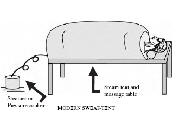
Swedana
(sudation or sweating) is given every day
immediately following the Snehana.
An herbal concoction may
be added to the steam to further
loosen the toxins from the individual. Swedana
liquefies the toxins and increases the movement of
toxins into the gastro-intestinal tract.
Pradhanakarma:
Main Purification measures of Panchakarma
Vamana: Emesis Therapy
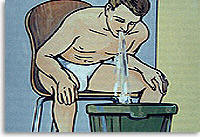
When there is
congestion in the lungs causing repeated attacks of
bronchitis, colds, cough or asthma, the Ayurvedic
treatment is therapeutic vomiting, Vamana, to
eliminate the Kapha causing the excess mucus.
Virechana: Purgation Therapy
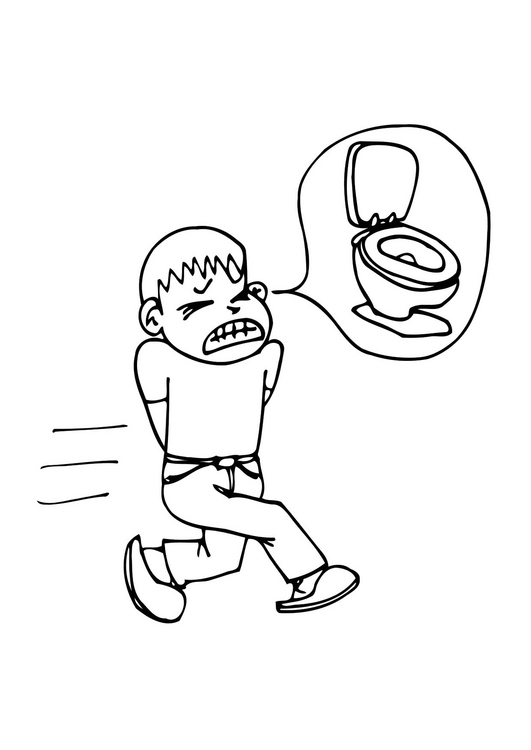
When excess bile,
Pitta, is secreted and accumulated
in the gall bladder, liver and
small intestine, it tends to result in rashes, skin
inflammation, acne, chronic attacks of fever,
biliary vomiting, nausea and jaundice. Ayurvedic
literature suggests in these conditions the
administration of therapeutic purgation or a
therapeutic laxative.
Nasya:
Nasal Administration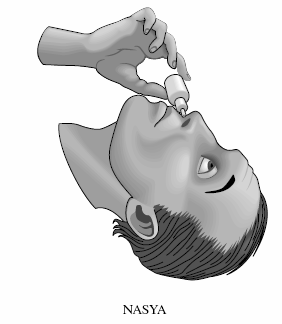
The nose is the
doorway to the brain and it is also the doorway to
consciousness. The nasal administration of
medication is called Nasya. An excess of bodily
humors accumulated in the sinus, throat, nose or
head areas is eliminated by means of the nearest
possible opening, the nose.
Basti:
Enema Therapy
Vata's predominant
site is the colon. Ayurvedic Basti involves the
introduction into the rectum of herbal concoctions
of sesame oil, and certain herbal prepa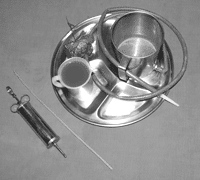 rations
in a liquid medium. Basti, is the most effective
treatment of Vata disorders,
although many enemas
over a prescribed period of time are usually
required. It relieves constipation, distention,
chronic fever, cold, sexual disorders, kidney
stones, heart pain, backache, sciatica and other
pains in the joints. Many other Vata disorders such
as arthritis, rheumatism, gout, muscle spasms and
headaches may also be treated with Basti. Basti
therapy is divided in two main types, i.e.
Anuvasana Basti or
medicated oil enemas and
Niruha Basti or medicated enema of decoctions
and medicated oils. rations
in a liquid medium. Basti, is the most effective
treatment of Vata disorders,
although many enemas
over a prescribed period of time are usually
required. It relieves constipation, distention,
chronic fever, cold, sexual disorders, kidney
stones, heart pain, backache, sciatica and other
pains in the joints. Many other Vata disorders such
as arthritis, rheumatism, gout, muscle spasms and
headaches may also be treated with Basti. Basti
therapy is divided in two main types, i.e.
Anuvasana Basti or
medicated oil enemas and
Niruha Basti or medicated enema of decoctions
and medicated oils.
Various
Other Panchkarma Procedures
ABHYANGA (Massage)
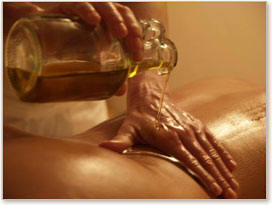 In this treatment,
Specific Body massage for 45-60 minutes with herbal
oil or herbal cream to tone up the body and to
improve the blood circulation etc. is performed. It
is useful for elimination of several aliments as
well as it is indicated as PURVAKARMA - pretreatment
procedure - for all the therapeutic Panchakarma
procedure. In this treatment,
Specific Body massage for 45-60 minutes with herbal
oil or herbal cream to tone up the body and to
improve the blood circulation etc. is performed. It
is useful for elimination of several aliments as
well as it is indicated as PURVAKARMA - pretreatment
procedure - for all the therapeutic Panchakarma
procedure.
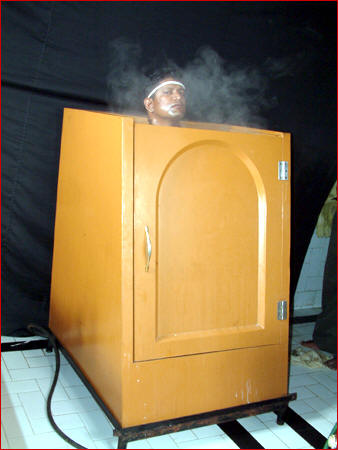 VASHPASWEDANAM: (Medicated Steam Bath) VASHPASWEDANAM: (Medicated Steam Bath)
This is a unique
treatment and under this treatment leaves of
medicinal plants are boiled and resulting steam is
passed to the whole body. This treatment is helpful
in to eliminate impurities from the body, reducing
fat and also helpful in fighting with some skin
diseases. This is also indicated as PURVAKARMA for
Panchakarma procedures.
SHIRODHARA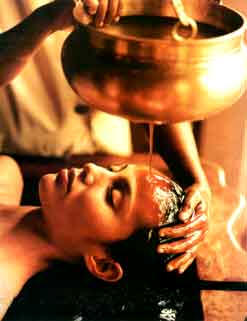
In this process
medicated water, herbal oils, medicated milk etc.
are poured on the forehead through a special method
for 30 to 45 minutes. This treatment is very useful
for mental tension, stress, hypertension, insomnia,
Vata predominated diseases and certain other
diseases.
MUKHLEPA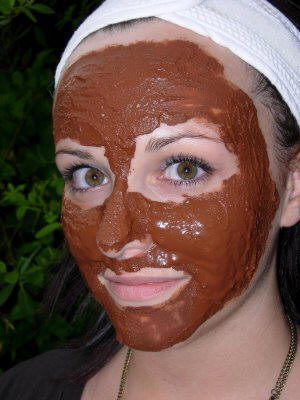
This is an herbal
face pack with specially made herbal powder and
fresh cream. This prevents and avoids wrinkles and
improves the skin tone. This is also good for the
eyes.
MARMA MASSAGE
This massage
includes whole body massage with herbal oil or
powder by hand and foot, for 90 minutes. This is
good for rejuvenating the body, to reduce mental
tension, sexual weakness, to improve vitality etc.
relieves back pain, stiffness and sports injuries
but also stimulates various bodily organs and
systems.
PATRAPOTALI
PINDA SWEDA
Herbal leaves and
herbs or herbal powders are applied to the whole
body in boluses with hot medicated oils for 45
minutes per day for a period of 7 to 14 days. This
treatment is for osteoarthritis, arthritis,
swelling. Spondylitis, sports injuries etc.
KATI VASTI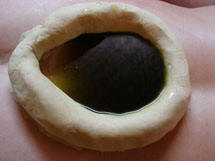
In this process
specially prepared warm medicated oil is kept over
the lower back with herbal paste boundary. This
treatment lasts for 45 minutes to 1 hour and it is
good for any type of back pain and spinal disorders.
NASYAM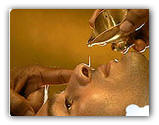
Herbal juices,
medicated oils through the nose for 7 to 14 highly
effective for certain kinds bells palsy, writers
cramps, disorders, insomnia depression, certain
types of skin diseases etc.
SHIROBASTI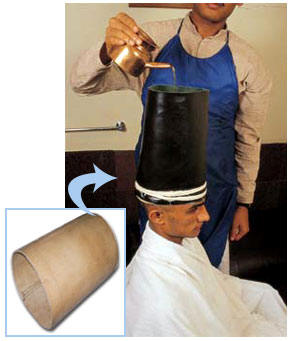
Certain lukewarm
herbal oils are poured into a cap fitted on the head
for 15 to 60 minutes per day according to the
patient’s conditions for
a period of 7 days. This
treatment is highly effective for mental stress,
rejuvenation of sensory organs, facial paralysis,
dryness of nostrils, mouth and throat, severe
headaches, burning sensation of head and other vata
predominant diseases.
PIZHICHIL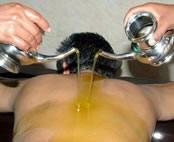
In this treatment,
lukewarm herbal oils are applied all over the body
by two to four trained masseurs in a special
rhythmic way for about 60 to 90 minutes per day fora
period of 7 to 21 days. This treatment is very
useful for rheumatic diseases like arthritis,
paralysis, hemiplegia, and nervous disorders etc.
NAVARAKHIZHI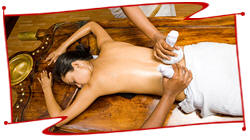
It is a process by
which the whole body or any specific part thereof is
made to perspire by the application of certain
medicated puddings externally in the form of boluses
tied up in a muslin bag. This is applied by two to
four masseurs for about 60 to 90 minutes per day for
a period of 14 days. This treatment is for
rheumatism, pain in the joints, emaciation of limbs,
blood pressure, cholesterol and certain kind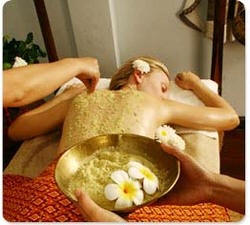 s of
skin diseases. s of
skin diseases.
UDHAVARTANA
This is a typical
massage with herbal powders for about 30 minutes
daily for a period of 3 to 28 days. This treatment
is for oily skin, to enhance the luster and glow of
the skin and for the diseases like obesity (excess
fat) and certain rheumatic ailments.
NETRA TARPANA
This is the cleaning
process of the eyes which gives cooling effect.
Prevents eye diseases and strengthens the optic
nerve. It is very effective at treating eye diseases
and poor or blurred vision.
|